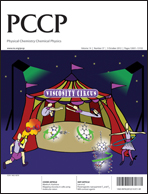High capacity of an Fe–air rechargeable battery using LaGaO3-based oxide ion conductor as an electrolyte†
Abstract
Rapid growth and improved functions of mobile equipment present the need for an advanced rechargeable battery with extremely high capacity. In this study, we investigated the application of fuel cell technology to an Fe–air rechargeable battery. Because the redox potential of Fe is similar to that of H2, the combination of H2 formation by the oxidation of Fe with a fuel cell has led to a new type of metal–air rechargeable battery. By decreasing the operating temperature, a deep oxidation state of Fe can be achieved, resulting in enlarged capacity of the Fe–air battery. We found that the metal Fe is oxidized to Fe3O4 by using H2/H2O as mediator. The observed discharge capacity is 817 mA h g−1-Fe, which is approximately 68% of the theoretical capacity of the formation of Fe3O4, 1200 mA h g−1-Fe, at 10 mA cm−2 and 873 K. Moreover, the cycle stability of this cell is examined. At 1073 K, the cell shows a discharge capacity of ca. 800 mA h g−1-Fe with reasonably high discharge capacity sustained over five cycles.


 Please wait while we load your content...
Please wait while we load your content...